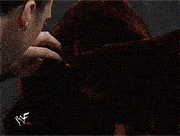|
Kvlt! posted:Update on my modal guitar progression (and please tell me to stop if these are annoying). exactly what the thread is for...keep the posts coming Kvlt! posted:It really struck me when someone itt said "focus more on the notes your EMPHASIZING modally". So I took the jam section of one of my favorite songs to solo to (Tweezer by Phish), realized I didn't wanna start on a song that has minor 7ths, and just picked a simple A > D chord progression to solo over. great - i'll give you the short version, then a more advanced way of thinking about this for Am - Dm, you're actually talking about two entirely different modes from an Amaj - Dmaj vamp. notes in A natural minor: A B C D E F G. Dm triad is diatonic to this scale (D - F - A), but the scale is not the same as D natural minor. these notes actually create the D *Dorian* mode. to start, you can play this scale, emphasizing chord tones, A C E and D F A over Am and Dm respectively. however, if you really want to emphasize the Dorian sound over Dm, you also want to emphasize the natural 6th - B. so, you can give that a try. the long version: any mode with a minor tonic triad could be used over a Dm chord. the main note you need to avoid is F#, because that would make it a D major chord - a different sound. this gives you a few options: D Dorian D Aeolian (natural minor) D Phrygian D Melodic Minor D Harmonic Minor you choice of which to use depends on the sound you're going for. Dorian has a bit "brighter" of a sound with its natural 6th (a personal favorite of mine). Phrygian will sound a bit darker due to the b2, which can be useful if you want to resolve down to the 1. Phrygian can also have a lovely "Spanish" sound. Melodic Min. and Harm. Min. are less likely choices because they have a natural 7th which tends to establish the key. ultimately, your choice comes down to a) personal preference and b) any melody notes that you want to emphasize. for example, if the melody contains a Bb, you probably don't want to play Dorian. but, i wouldn't worry too much about that if you're just practicing. try them all and see what you like. when you're soloing you can go in and out of different modes as you like!
|
|
|
|

|
| # ? Jun 8, 2024 00:01 |
|
a.p. dent posted:exactly what the thread is for...keep the posts coming Just wanted to say thank you for this write up. Your style of explaining music theory is really great and makes this crazy mode stuff a lot easier to wrap my head around (and in turn, I have more fun playing too). Going to digest and practice this and report back!
|
|
|
|
Another modal question: When soloing over stuff like thrash/death metal, where I have to play over riffs/power chords, I generally find what key the has the most notes in common and just do a minor pentatonic or blues thing over that, but obviously that's not really the sound of death/thrash metal. I notice a lot of guys say to use the Phrygian mode, but the power chords move so fast you'd only get to emphasize the Phrygian for a second or two. I guess the basic question is, the modes make a lot more sense to me when soloing over chords, but I have no idea how to do it over riffs/power chords. e: Sorry for the accidental doublepost
|
|
|
|
most players in heavy styles aren't playing changes over every chord, at least not that consciously. the easiest way to approach it imo is to just explore the tonic's parallel phrygian (so like E phrygian if you have an E minor chord as your home base). don't over-complicate the modes, you're just playing major or minor with one note changed (two for locrian, locrian is a special weird case). the important thing is learning to be expressive within the modes, instead of being able to quickly barf out a bunch of stale patterns because you're rushing through changes. people like the phrygian sound vs conventional minor because it creates a strong sense of resolution to the tonic; this is because the ♭2 is an incredibly tense interval, and generally resolves really strongly back to the root. see if your riff has a ♭2 or a natural 2, and be aware that playing the other one will be very dissonant in most scenarios.
|
|
|
|
creamcorn posted:most players in heavy styles aren't playing changes over every chord, at least not that consciously. the easiest way to approach it imo is to just explore the tonic's parallel phrygian (so like E phrygian if you have an E minor chord as your home base). You're right, I just threw on a quick loop of a basic DM riff in (roughly) the key of E and just blended E Phrygian in with my usual style and it was a lot of fun. Gonna play with it more and experiment with those dissonant natural 2 you mentioned. Thank you! One of the things everyone has mentioned that I'm really learning is the concept of using the modes as a spice, not a meal, and it's really opened up my understanding of them and made my playing a lot more fun, and I'm only doing the beginner stuff
|
|
|
|
yeah i tend to think modal textures work best more as a way of differentiating textures or sections from each other rather than an out and out alternative to "this piece is in D minor"
|
|
|
|
Kvlt! posted:Just wanted to say thank you for this write up. Your style of explaining music theory is really great and makes this crazy mode stuff a lot easier to wrap my head around (and in turn, I have more fun playing too). Going to digest and practice this and report back! thanks!! i'll let other people comment on metal cause i don't know much about that
|
|
|
|
I'm not a big metal person, or even a good theory person. But with modal highlights, for playing the changes, all you really need to do is hit the modal note that's different to indicate that mode to the listener. Phrygian is mostly knowable by the flat two. Locrian by flat five. And Dorian with a natural six relative to minor. Also power chords don't indicate chord quality, but their root or bass player or melody does often indicate the tonal center, and quality is naturally assumed by the listener. So if you're soloing over a power chord, hitting the notes like the natural six if you're over a diatonic minor progression is the telegraph that you're in Dorian. Flat 2 for Phrygian, etc. This is gonna sound weird if you are playing over a power chord whose root indicates a chord number that would have some note in it that clashes with the modal choice. Like if they are playing a iv chord and the song isn't in Phrygian but you nail a flat two.
|
|
|
|
|
Modal update: Not much to report because I've just been focusing on practicing everything I've learned so far. Here's what I've noticed Playing modal licks over a drone note or chord really helps me learn how each mode sounds, and in turn when to use it in playing. I find when I do this, it's particularly easy to get into "scale running" and just playing the modes as a scale, which is an easy trap to fall into when there's no chords changing. So i've determined it's good to use as a way to train my ear to the flavors of modes and experiment with, but not great to practice extensively too. The main tactic I've been applying, the one that really made the modes click for me is "find the notes in the mode that match the chord, and emphasize those notes". It's really rewarding messing around in pentatonic and then adding a modal lick. I wish there was a way to quickly find which modal scale notes match with different chords, so I guess I gotta do some hard memorization. I'm a big jam band and death metal guy so I've been experimenting a lot with mixo and phyrigian.
|
|
|
|
Sorry for the double post, I have a quick question. I've just been working on my mode work and I notice sometimes the mode will "come through" even if it's not over the correct chord. For example if I'm jamming to a chord progression in A major, if I play the A mixo scale over it, it can sometimes sound "mixolydian", even when I'm playing A mixo over a chord that isn't A. Could someone explain what's going on here?
|
|
|
|
Kvlt! posted:Sorry for the double post, I have a quick question. I think you've got some concepts mixed up. Modes aren't really associated with chords. There's no such thing as the "correct" chord for a given mode any more than there is the correct cord for a major or minor scale.
|
|
|
|
It definitely confuses me because the exercise I've been practicing is this Let's say chord progression is G > C > D in G major. I use the G major scale as my basis for my improvisation/solo. I know C is the 4th of G, so I find the notes that the C major chord and G mixo scale share and try to emphasis those notes over the C chord. But I can also play the G mixo scale over the entire progression and it sounds cool too. So I'm definitely making some fun licks, but I really don't know what I'm doing, because modes scramble my brain Upon reviewing this post I think I might be just playing arpegios, because the notes the C major chord and the G mixo scale share are just the notes that make up C major chord. This stuff is tough! Kvlt! fucked around with this message at 02:34 on Aug 3, 2022 |
|
|
|
Well, G major will work over the whole thing because it's in G. But if you're playing triads, there really isn't a way to tell you're in G. The D chord should be minor if you want to firmly be in G. G mixolydian would work over a G dominant chord, or in C. But because of the F# in G, it won't work over a piece well in G Ionian. If you're playing an F natural as part of your D chord, you're telegraphing C. If it's D, F# A, then you're telegraphing G. If you are in G, and you wanted to play modal licks over each chord, then the C chord should get C lydian, the G would get Ionian and the 6, D would get Aolean or natural minor.
|
|
|
|
|
Basic Poster posted:Well, G major will work over the whole thing because it's in G. But if you're playing triads, there really isn't a way to tell you're in G. The D chord should be minor if you want to firmly be in G. Okay this cleared up a lot of things for me, thank you! I appreciate it. The one question I'm still having trouble understanding is why I can play only the G mixo scale over G > C > D and it sounds good (to me at least) over the whole progression. Why is that? Or maybe it sounds awful and I'm just liking that it sounds awful.
|
|
|
|
e: Apologies, accidental double post
|
|
|
|
The only conflict there is the F in G mixo and the F# in the D major chord; if you're not hanging out on the 7th a lot it might not even be noticeable. If the voicing of the D chord puts the F# far away from where you would put the F in your jamming it would probably still sound fine even if you did hang out on it a lot
|
|
|
|
Kvlt! posted:mixo scale ... and it sounds good (to me at least) In addition to the theory explanation, listening to a lot of Phish and the Dead will do that to ya after a while (or it did to me). Similar thing happened w/ psytrance and metal and phryggian
|
|
|
|
Kvlt! posted:Okay this cleared up a lot of things for me, thank you! I appreciate it. it could be that it sounds “bluesey” to you, as blues often combines both the 3 and b3. it’s characteristic of the blues sound and will probably also sound like “rock music”. a more complex, jazzy explanation could be that you’re playing an extended D7 chord with a #9 (which would be E#, or just F natural enharmonically). for V7 chords, which is likely how the D is functioning (as the V of G), you’re “allowed” to add basically any extension - they all sound good. (a dominant 7th chord contains the tense tritone, which “allows” you to add more tension without causing problems). or something like that! anyway, if you like the sound, that’s what matters
|
|
|
Kvlt! posted:Okay this cleared up a lot of things for me, thank you! I appreciate it. Well, look at the notes in the chords: GBD CEG DF#A I can get out of there GABCDEF# (G major). G Mixo is GABCDEF. One note off and F natural could be a passing tone, or the 7th of the G chord or the etc. These are very close keys so it wont sound real out regardless.
|
|
|
|
|
Kvlt!, When you're played "modally" (quotes are doing a lot of heavy lifting), are you just doing box shapes or are you aware of the intervals of the notes you're playing against each other and against the underlying chord changes?
|
|
|
stratdax posted:Kvlt!, When you're played "modally" (quotes are doing a lot of heavy lifting), are you just doing box shapes or are you aware of the intervals of the notes you're playing against each other and against the underlying chord changes? This is a good post. Modes are one of the few things that are easier to visualize on a guitar.
|
|
|
|
|
One of my favorite mental activities while running is figuring out what notes are actually in a shape or chord and what changes when I move things. By the time I get back to a guitar, I'm ready to test out playing it in new spots. Today I was thinking about Am, Am7, Fmaj7, Fmaj9, G7, and G chords on the top 4 strings and how they all relate to a bass A note
|
|
|
|
JesustheDarkLord posted:One of my favorite mental activities while running is figuring out what notes are actually in a shape or chord and what changes when I move things. Maybe it's just that I haven't played guitar in a while, but the thought of trying to do that while running makes me wonder how you don't wind up on the side of the road with your legs bent in strange directions.
|
|
|
|
Rocko Bonaparte posted:Maybe it's just that I haven't played guitar in a while, but the thought of trying to do that while running makes me wonder how you don't wind up on the side of the road with your legs bent in strange directions. serious guitarists should try learning the names of all the notes on the fretboard. there are a lot of reasons why! for example, it lets you communicate more effortlessly with other musicians this is learnable by adults: https://www.musictheory.net/exercises/fretboard many years ago, I used something similar that runs on android phones to practice on the train to work. The trick is to start with memorizing the top two strings, because then you can use octave shapes to cheat on the other 4!
|
|
|
|
JesustheDarkLord posted:One of my favorite mental activities while running is figuring out what notes are actually in a shape or chord and what changes when I move things. By the time I get back to a guitar, I'm ready to test out playing it in new spots. definitely going to try this . It's cool to play an imaginary guitar when you cant have your real guitar for some reason
|
|
|
|
Ive got this chord progression. Or two that Im trying to link together from pretty distant keys. And Im not sure quite how to resolve the second one so that it goes back to the other distant key. I could use a pedal or some other trick but looking for some theoretical help. The First part goes: (leaving out any voice leading but generally trying to keep the melody notes as pedal for now, or by step) AbM7, Fm7, Gaug7, B/C and the escape is instead of going to the Gaug7, it goes AbM7, Fm7, FM7/G which leads to the second part Am7, Em7, Dm7, Gaug back to the top. The escape chord I'd like to use on the last phrase is a Am7, Em7, BbM7 to Dm7 but cant figure out a decent turn around to get back to the AbM7 I started at basically going from what I believe to be Eb, and the FM7/G seems to walk me into Am fine, but going from Dm7 to AbM7 feels real clunky without a turn around I've tried tonicising the Ab with a Eb7, but its clashy. Hve Tried to tritone sub to tonicize it. Didnt sound great. Basic Poster fucked around with this message at 19:20 on Aug 12, 2022 |
|
|
|
|
Try tonicizing the Ab with a Gdim7, which functions as the vii* of both Ab and D?
|
|
|
|
Remalle posted:Try tonicizing the Ab with a Gdim7, which functions as the vii* of both Ab and D? I did try that! It does work but not real well(for the context of the piece, theory wise it's real cool) Very cool idea though to have that option of dominant in two keys at once being the v and vii. Wicked smart. Since the second part has that Bb major in it and the a minor, at the end of the section I ended up vamping between Am7 and BbM7 a few times and as an escape thing kept the Bb in the bass but moved the chord to AbM7 which works pretty good to move the root to Ab at the new bar line. Same that happened with the FM7/G. 9th in the bass. Boy that sure is a sound I'm going through have to try hard not to overuse.
|
|
|
|
|
More mode questions! When using modal mixture, is it correct or not to assume that some borrowed chord from a parallel mode, if it’s 1:1 in terms of Roman numeral, does the borrowed chord provide the same function as a diatonic one it replaces? For example if a ii-V-I is in C is predominant, dominant, tonic, would borrowing a bII or a v or a i still all have PD,D,T functions as subs?
|
|
|
|
|
Basic Poster posted:More mode questions! it can be, but not necessarily, because context matters! in other words, the preceding and following chords determine your functional analysis -- not the other way around. For a simple example, if you start by playing in C major, then borrow the I chord from the parallel mixolydian mode (C mixolydian), that can give you a C7 chord, which we would call a secondary dominant if the next chord is an F. But if some other chord follows, arguably, that C7 could be the "tonic" of mixolydian, and whatever comes next could be some kind of pre-dominant. Basic Poster posted:For example if a ii-V-I is in C is predominant, dominant, tonic, would borrowing a bII or a v or a i still all have PD,D,T functions as subs? Not sure, there's surely contexts where they do. But I would need a more specific example to work with.
|
|
|
|
hey y'all o7 i'm a sophomore in college taking my first proper music theory class. i've had experience in band since elementary but i've never been made to memorize scales and key signatures before (and it's confusing for me because i play clarinet, so i'm always having to transpose whatever i learn) and yeah. we're supposed to memorize the scale patterns for the twelve major and natural, harmonic, and melodic minor scales and i'm seriously struggling. do y'all have any tips that might help for studying? stuff like 'beadgcf to remember the flat order' and such. thanks : )
|
|
|
|
Instead of memorizing each note for each scale, memorize the intervals between each note for a given type of scale. E.g. for a major scale you have intervals of M2, M2, m2, M2, M2, M2, m2
|
|
|
|
Circle of fifths sounds like it would help you a lot. If you go clockwise (down a 5th), each major/natural minor scale adds one more flat until you flat everything, then you give up and translate everything to sharps, then each scale is minus one sharp until you’re back to C. If you go counterclockwise (up a 5th), you add one sharp/subtract a flat. If you know that and you memorize one key signature and its major and minor key, you should be able to calculate anything else. Example: no flats/no sharps is C major and A minor. If you know that and are asked to name the sharps in D major, you can go counterclockwise on the circle C - G (one sharp) - D (two sharps). You can then use the order of sharps to determine they are F# and C#. If you’re given a key sig and asked to find the major/minor scale associated, the quick way to figure it out is this: Work from major first. Memorize C major (no sharps/flats) and F major (one flat) because the pattern doesn’t work for them. Key sig with flats: the second to last flat is the major key. (Example: two flats = Bb major) Key sig with sharps: one half step up from the last sharp is the key. (Example: four sharps = last sharp is D# = E major) The relative minor that shares the same key sig is then the 6th note of the major scale. Examples: Bb major and G minor, E major and C# minor, F major and D minor. Does that help? Edit: forget about melodic/harmonic minor for now and just focus on major/natural minor because the other two minors, key signature-wise, are identical. They just use accidentals to modify the scale (like F# in G harmonic minor)
|
|
|
|
Hawkperson posted:Circle of fifths sounds like it would help you a lot. If you go clockwise (down a 5th), each major/natural minor scale adds one more flat until you flat everything, then you give up and translate everything to sharps, then each scale is minus one sharp until you’re back to C. If you go counterclockwise (up a 5th), you add one sharp/subtract a flat. If you know that and you memorize one key signature and its major and minor key, you should be able to calculate anything else. this does help, thank you!! everything makes.... a lot more sense once i look at the circle of fifths. i'll try to memorize it. i have a background of ukulele so looking at the notes and realizing each one leads to a chord i can use in each key- for example, c and g go together, then g and d, and so on- is quite interesting. and the thing about counting up from sharps is super helpful. i really appreciate it.
|
|
|
|
bltzn posted:Instead of memorizing each note for each scale, memorize the intervals between each note for a given type of scale. this is the same concept of w w h w w w h right? and then for minor it's w h w w h w w ?
|
|
|
|
barclayed posted:this is the same concept of w w h w w w h right? and then for minor it's w h w w h w w ? Yep. A major 2nd is a whole tone, a minor 2nd is a half/semi-tone. For minor it actually depends if you're playing harmonic, melodic, or natural minor. Natural is: M2, m2, M2, M2, m2, M2, M2 Harmonic is: M2, m2, M2, M2, m2, A2, m2 Melodic is: M2, m2, M2, M2, M2, M2, m2 when ascending and the same as natural minor when descending.
|
|
|
|
bltzn posted:Yep. A major 2nd is a whole tone, a minor 2nd is a half/semi-tone. A2?
|
|
|
|
Augmented second - a whole step plus a half step, or three half steps if you prefer. In C, that harmonic minor scale ends G - Ab - B - C, with an augmented second between the Ab and B (enharmonically equivalent to a minor third G# - B, but spelled differently to avoid having two notes with the same letter name in the same scale).
|
|
|
|
|
Is there a good place online to learn about what each note type sounds like when played together? I'm using a free trial of Scott's Bass Lessons and every video has an example of a lick and they go WAYYY too fast for me to follow along and they don't seem to have a lesson on most of the actual sheet music. Here is the example I'm stuck with. It sounds like she plays two notes when she does the first triplet and I don't understand why. What is the little flag looking thing after the triplet?
|
|
|
|

|
| # ? Jun 8, 2024 00:01 |
|
a pale ghost posted:Is there a good place online to learn about what each note type sounds like when played together? I'm using a free trial of Scott's Bass Lessons and every video has an example of a lick and they go WAYYY too fast for me to follow along and they don't seem to have a lesson on most of the actual sheet music. If you're referring to the note right after the rest, it's just a sixteenth note. If you Google "interval ear trainer" or "chord ear trainer" there are a few results that come up that you might find useful
|
|
|



















